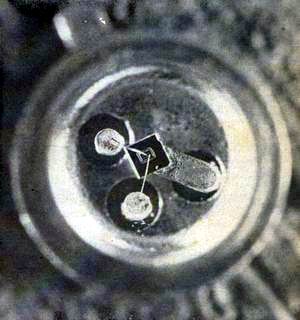 |
| Fig.273 - Enlarged
view of mesa TRANSISTOR, showing its inner structural arrangement.
|
The diffusion method offered several advantages over earlier transistor-making
processes. Thus, by controlling the parameters used during the manufacturing
like: temperature, vapour pressure and time, the depth of DOPE entered
in the crystal matrix could be accurately predictable in such way
to obtein uniform thickness of the base region. Fig 273
The Mesa TRANSISTOR, named due to the flap-topped mountain shape
of its cross section was the first semiconductor device made by
diffusion method.
Due to the sturdy construction approach, they could dissipate more
heat being capable to operate in high frequency levels and consequentely
they were suitable for video signal amplifiers applications in the
UHF bands.
In 1959, the Dutch company Philips introduced a similar semiconductor
device like the mesa TRANSISTOR known as POB, an acronym for: "Pushed
Out Base". The POB TRANSISTOR has opened the way towards transitorization
in the field of shortwaves, frequency modulation and even television.
Apparently the Mesa TRANSISTOR was a major advancement as a solid-state
amplifier. However, the diffusion method had some drawbacks, as
it was relatively fragile and still subject
to surface contamination.
In order to figure out a way to overcome the aforementioned drawbacks
the Fairchild engineers developed the Planar TRANSISTOR.
|
